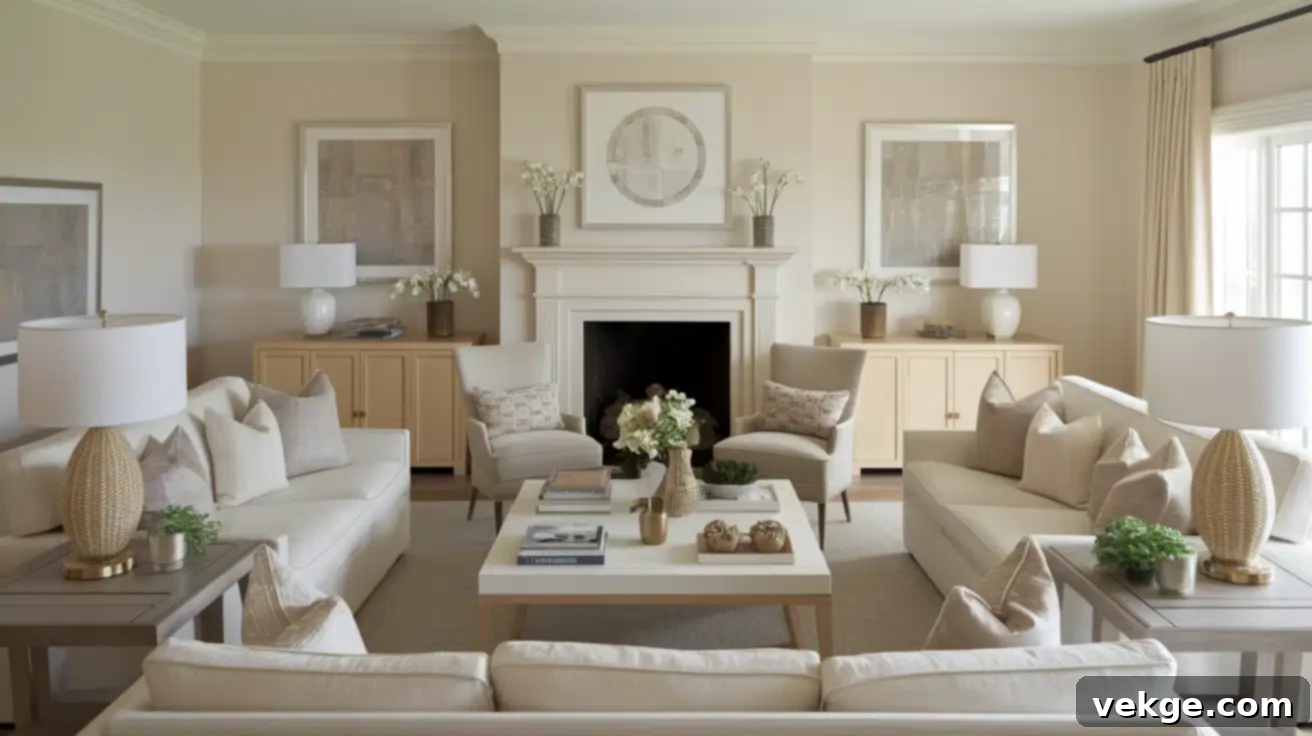Achieve Serenity: The Power of Symmetry in Interior Design for a Balanced Home
Have you ever stepped into a space and instantly felt a deep sense of peace and order? That comforting feeling often springs from the strategic use of symmetry in interior design. Creating balance in your home isn’t merely about aesthetics; it’s a powerful tool that profoundly influences how you experience your living environment.
This comprehensive guide will demystify symmetry, offering practical and accessible methods to infuse balance into every room of your house. You don’t need to be a seasoned design expert or invest heavily to transform your space. With a few thoughtful adjustments, you can craft environments that feel inherently more tranquil, organized, and inviting. Whether you’re planning a complete living room overhaul or seeking to make your bedroom a more restful sanctuary, these simple symmetry principles can revolutionize your home into a truly harmonious retreat.
What is Symmetrical Balance in Interior Design?
Symmetry is a foundational principle that brings an undeniable sense of equilibrium and visual harmony to your rooms. It’s a design approach that, while simple in concept, possesses immense power to make any space feel cohesive, intentional, and remarkably calm. When interior designers discuss symmetry, they are referring to the deliberate arrangement of elements such that one side of a central axis or focal point mirrors the other.
Definition and Core Concept of Symmetrical Design
Symmetrical balance is achieved by arranging identical or very similar items on opposing sides of a defined central point or line. Imagine folding a piece of paper in half; the elements on one side would precisely match or closely resemble those on the other. This form of balance operates around a central axis within your room, which could be an architectural feature like a fireplace, a large piece of furniture like a sofa, or even an imaginary line running through the center of a wall.
For instance, when you place two matching table lamps on either side of a console table, or position identical armchairs facing each other across a coffee table, you are employing symmetrical balance. The essence lies in the mirrored placement of items to establish a clear and satisfying visual equilibrium. This mirroring creates a predictable and pleasing pattern that the human eye naturally finds appealing and relaxing.
Why Symmetrical Balance is Crucial for a Calm Home
The importance of symmetry extends beyond mere aesthetics; it deeply impacts the psychological comfort of a space. Symmetrical arrangements make rooms feel stable, secure, and inherently peaceful. Our brains are hardwired to appreciate order and predictability, making symmetrically designed rooms feel inherently more relaxing and less chaotic than asymmetrical or poorly balanced ones.
Historically, many classic and formal interior design styles have heavily relied on symmetry. Consider the grandeur of an upscale hotel lobby, a traditional stately home, or a formal dining room. These spaces often feature matching sets of chairs, identical table arrangements, and balanced lighting fixtures, all working in concert to create an atmosphere of dignified calm and impeccable order. This timeless appeal underscores symmetry’s enduring power to elevate a space, making it feel both grand and grounded.
Key Elements for Creating Symmetry in Your Room
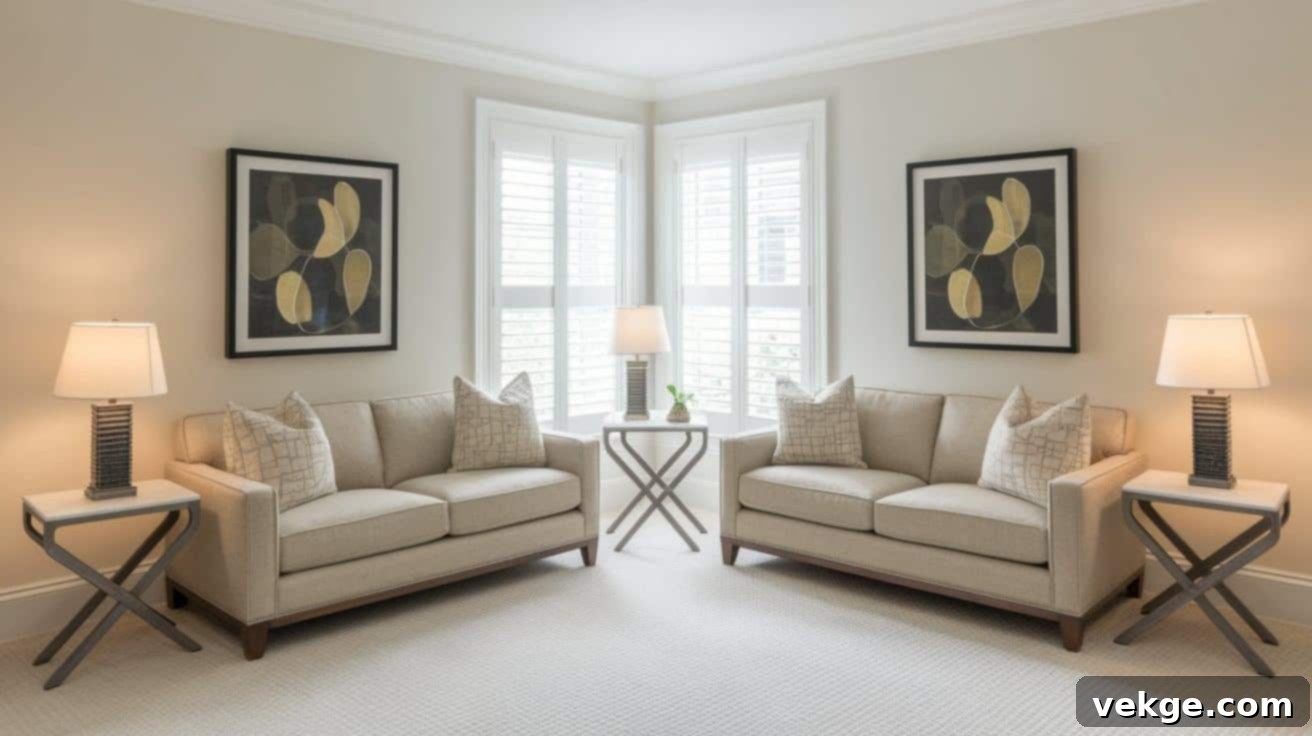
Infusing your space with symmetrical balance doesn’t require a complex strategy. With a few intentional choices, you can effortlessly cultivate a room that exudes calm and thoughtful design. Here’s how to introduce symmetrical touches that make your space feel perfectly composed and inviting.
Strategic Furniture Placement for Symmetrical Layouts
The arrangement of your furniture is arguably the most impactful way to establish immediate symmetry. Begin by identifying a central focal point, such as a fireplace, a prominent window, or a large piece of art. Then, arrange furniture pieces equally on either side of this anchor.
- Try placing two identical accent chairs directly across from each other, with a coffee table centered between them.
- Position your main sofa centrally against a wall, then flank it with identical side tables, each topped with a matching lamp.
- Even in smaller rooms, you can create balance by ensuring larger furniture pieces, like bookshelves or dressers, are evenly distributed or mirrored across an imaginary central line. This fundamental change in furniture layout can significantly enhance the room’s sense of organization and peacefulness.
Elevating Spaces with Symmetrical Wall Decor
Your walls provide abundant opportunities for incorporating symmetrical elements that tie the room together. Wall decor can be used to emphasize architectural features or create new focal points.
- Hang two similar picture frames or pieces of artwork on either side of a window, a grand doorway, or a large mirror.
- Install matching wall sconces on both sides of your bed, a console table, or a significant art piece to add both light and balance.
- If you have a prominent feature like a fireplace mantel or a television, consider adorning each side with identical decorative objects, such as vases, sculptures, or potted plants. Even simple elements like two similar plants in matching planters can introduce that satisfying sense of visual balance to your vertical surfaces.
Harmony Through Symmetrical Color and Texture
Beyond physical objects, using consistent colors and textures across a symmetrical arrangement profoundly contributes to overall harmony. These subtle yet effective design choices help to integrate all elements, creating a cohesive and polished look.
- Select throw pillows in pairs, ensuring they are identical or highly similar in color, pattern, and texture, and place them on opposing ends of your sofa or on matching chairs.
- Introduce two identical area rugs under side tables or at strategic points in the room to define zones and add softness.
- Curtains offer another effortless way to enhance symmetry. Identical drapes on both sides of a window frame the view perfectly, contributing to a sense of order and completeness. Repeating colors and textures subtly guides the eye, reinforcing the feeling of balance without being overly obvious.
Symmetry & Balance for Every Room in Your Home
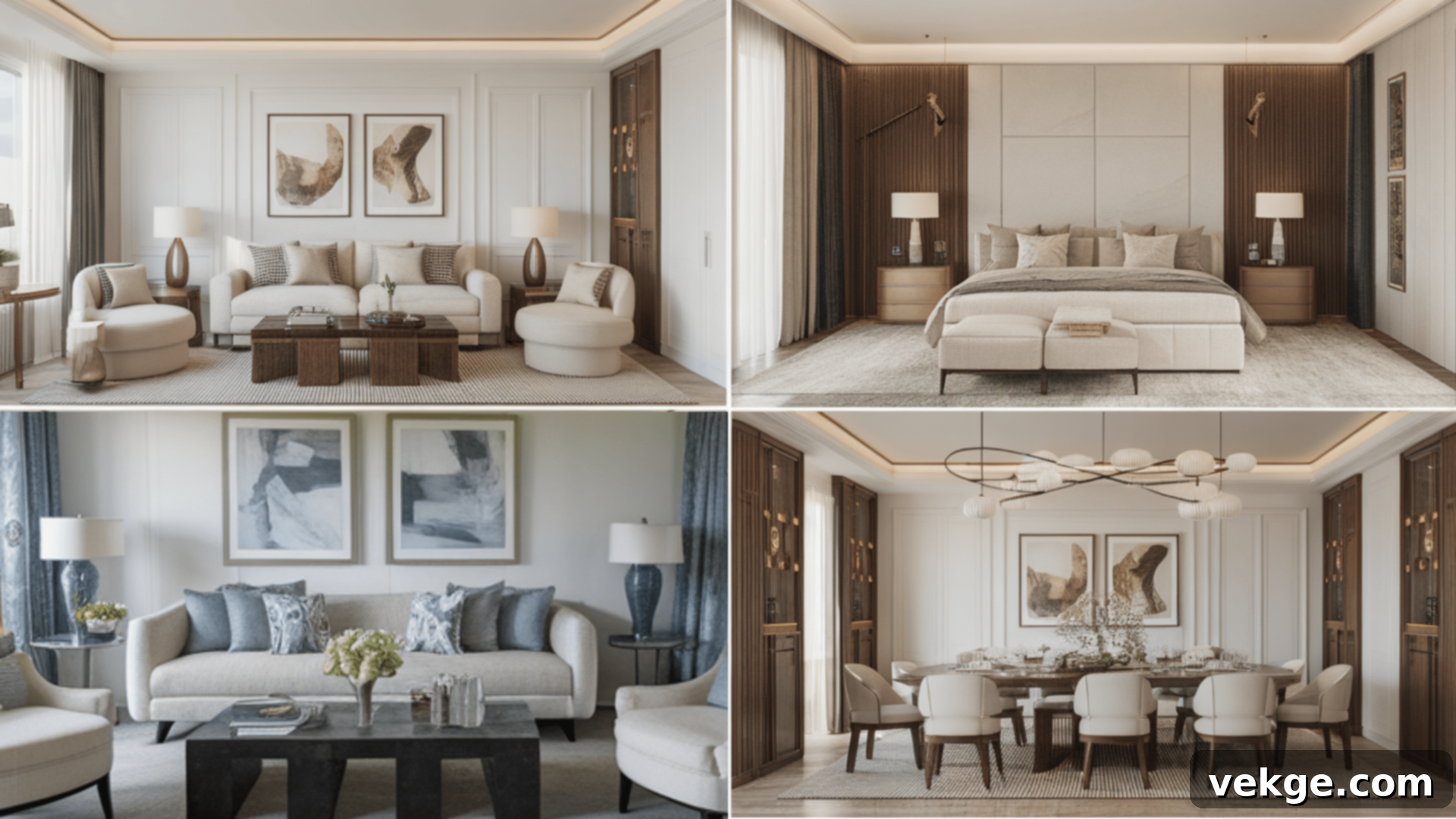
Every space within your home can benefit from the calming influence of symmetrical design. Let’s explore how to effectively apply these principles to various rooms, enhancing their unique functions and atmospheres.
Creating a Balanced and Inviting Living Room
The living room is often the heart of the home, and it’s where symmetry can truly shine, creating a welcoming and elegant environment. This central gathering space greatly benefits from a well-structured layout.
- Consider placing two identical sofas or loveseats facing each other, with a large, centered coffee table between them. This classic arrangement fosters conversation and creates a grand sense of balance.
- Alternatively, position matching armchairs on either side of a fireplace or a console table, defining a cozy seating area.
- Table lamps are an easy win for adding symmetry. Place similar lamps on end tables at opposite sides of the room, or on either side of a console table.
- Even smaller details like throw pillows can contribute to balance when you use pairs in the same color, pattern, or texture on opposing ends of your sofa. These deliberate choices make the living room feel both warm and sophisticated.
Designing a Restful and Symmetrical Bedroom Sanctuary
In the bedroom, symmetry is invaluable for fostering a calm, serene atmosphere conducive to rest and relaxation. The most natural starting point for symmetrical design is around the bed itself.
- Place matching bedside tables on each side of your bed, topped with identical lamps. This creates an immediate and comforting sense of balance and order, making the bed feel like a grounded focal point.
- Your window treatments also play a significant role. Identical curtains or blinds framing each window not only provide privacy but also contribute to a peaceful, symmetrical aesthetic.
- Even something as simple as two matching decorative throw pillows perfectly placed on your bed can bring that desired sense of order, making the bedroom feel exceptionally cozy and restful.
Elevating the Elegance of Your Symmetrical Dining Room
The dining room inherently lends itself to symmetrical arrangements, often built around the central dining table. This natural predisposition makes it an ideal space to emphasize balance and formality.
- Chairs placed evenly around a dining table already establish a fundamental balance. Elevate this by using matching place settings, glassware, and a centerpiece that aligns perfectly with the table’s middle.
- Wall decorations work particularly well in pairs here. Try hanging two similar pieces of artwork, mirrors, or sconces on opposite walls or on either side of a buffet.
- Even your lighting choices make a substantial difference. A beautifully centered chandelier above the dining table or evenly spaced wall sconces create that pleasing visual balance that makes mealtimes feel special, refined, and inviting.
How Symmetry Upgrades Your Room’s Aesthetics and Feel
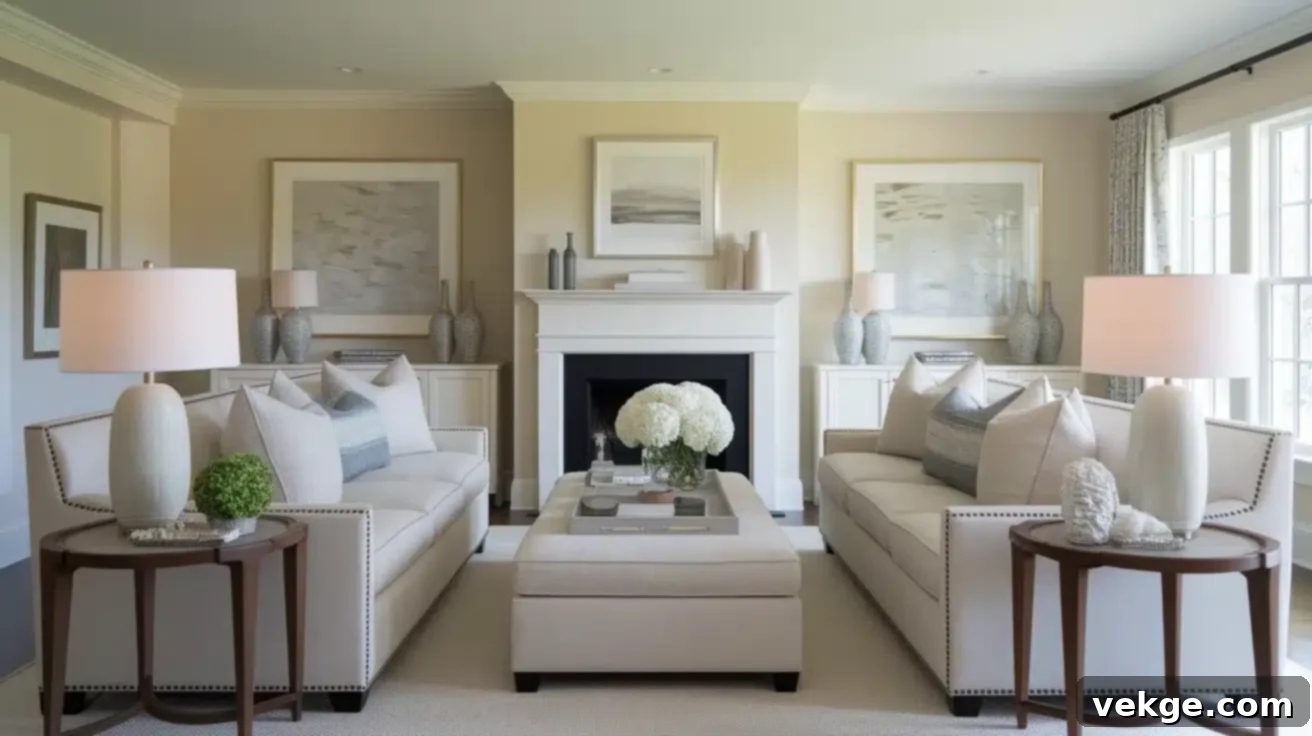
Embracing symmetrical design can profoundly transform the atmosphere and functionality of any room. When elements are thoughtfully matched and aligned, your space doesn’t just look better—it feels inherently “right.” A balanced room fosters relaxation and effortlessly enhances your home’s polished appearance, often with minimal effort.
Creating a Deep Sense of Calm and Stability
The human brain instinctively seeks patterns and order. When your eye perceives matching items distributed equally on both sides of a room, it registers a sense of completeness and visual satisfaction. This innate balance translates into a profound feeling of safety, security, and peacefulness within the space.
This is precisely why bedrooms and living rooms benefit so immensely from symmetrical layouts. After a demanding day, stepping into a balanced room allows your mind to unwind, destress, and find solace, contributing significantly to mental well-being and emotional comfort.
Adding Undeniable Formality and Class
Symmetry is a hallmark of sophisticated and traditional design. Matching chairs, identical lamps, and precisely paired artwork instantly create a polished, refined, and upscale aesthetic. This balanced style is consistently observed in luxurious settings such as high-end hotels, classic estates, and formal entertaining spaces.
The neat, organized, and predictable look that symmetry provides can elevate even the simplest of rooms, making them appear more intentional, well-planned, and inherently elegant without needing elaborate or costly decor.
Enhancing Practical Functionality and Flow
Beyond its aesthetic appeal, symmetrical room layouts often lead to improved functionality and a more intuitive flow. When furniture is arranged with balance, movement within the room becomes easier, more natural, and less obstructed. Clear pathways and logical groupings of furniture contribute to a more navigable space.
Your everyday tasks flow more smoothly in an organized environment. Furthermore, balanced rooms tend to minimize clutter because items often have clear, designated “partners” or specific spots within the symmetrical arrangement. This makes finding things, maintaining tidiness, and enjoying your home’s practical aspects much simpler and more efficient.
Symmetry vs. Asymmetry in Interior Design
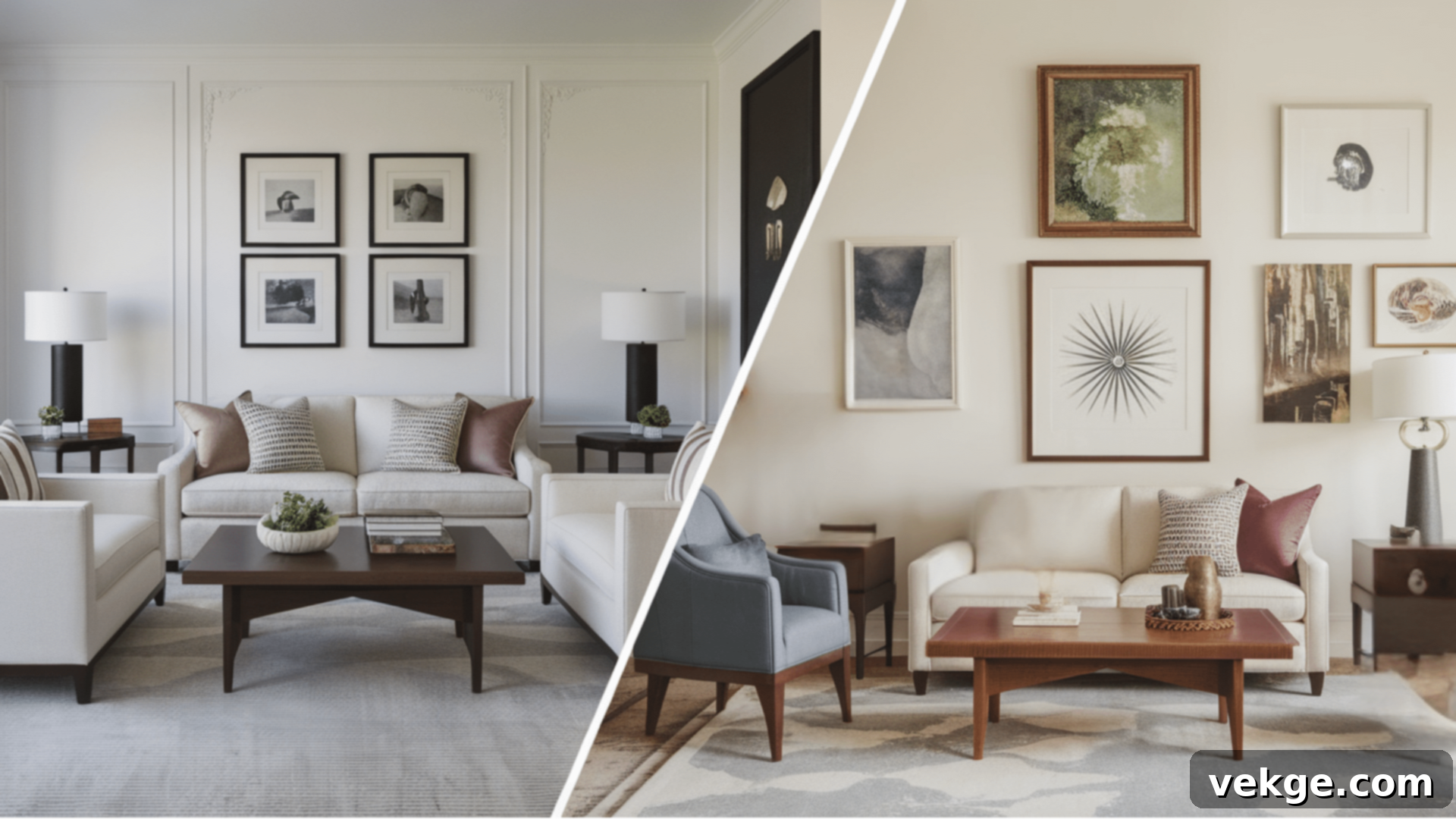
Both symmetry and asymmetry are powerful design principles, each capable of creating stunning and impactful rooms. Understanding their core differences is key to choosing the approach that best suits your personal style and the specific needs of your space. While symmetry delivers order and calm, asymmetry introduces dynamic energy and unique personality. In reality, many of the most compelling rooms skillfully blend elements of both approaches.
Key Differences Between Symmetrical and Asymmetrical Design
|
Feature |
Symmetry |
Asymmetry |
|
Feeling Conveyed |
Formal, serene, stable, traditional, elegant |
Casual, dynamic, modern, energetic, creative |
|
Ease of Creation |
Generally easier to achieve with clear guidelines |
Requires more artistic eye and design skill to balance |
|
Visual Impact |
Predictable, orderly, harmonious, restful |
Surprising, engaging, stimulating, often more unique |
|
Arrangement Precision |
Demands precise mirroring and matching |
More forgiving; relies on visual weight and balance |
|
Best Suited For |
Formal living areas, bedrooms, traditional homes, professional offices |
Creative studios, modern apartments, eclectic living spaces, kids’ rooms |
Choosing the Right Balance for Your Home
When deciding which approach is right for you, reflect on the desired atmosphere of your room. If your primary goal is to foster calm, order, and a classic aesthetic, then embracing symmetry will likely be your best bet. This style is ideal for private spaces like bedrooms, or formal areas such as dining rooms, where peace and a sense of refinement are paramount.
Conversely, if you’re drawn to creativity, a sense of movement, and unexpected visual interest, exploring asymmetry in spaces like a casual living room, a home office, or an art studio might be more fulfilling. Many homeowners find that a thoughtful blend works best: employing symmetry for the larger, foundational pieces of furniture and architectural elements, while introducing asymmetry through smaller decorative details and accessories to add personality.
Balancing Symmetry with Other Design Principles
Symmetry, while powerful, doesn’t have to result in a rigid or monotonous space. The most beautifully designed rooms often master the art of knowing when to adhere to symmetrical principles and when to subtly introduce deviations. Thoughtfully integrating unexpected elements into a predominantly balanced space creates rooms that feel both orderly and richly interesting.
Integrating Asymmetry for Added Visual Interest
Perfect, unyielding symmetry can occasionally feel too stark or overly formal, sometimes even sterile. To counteract this, consider breaking up the visual repetition by introducing one unique, non-mirrored piece into an otherwise symmetrical room. For example, you might place a vibrant, art-deco-inspired chair on only one side of a symmetrical sofa arrangement, or use different, yet complementary, throw pillows on a matching sofa set.
Even small, subtle touches can add immense personality while maintaining an overall sense of balance. A single, tall floor plant in one corner, a curated stack of books on one side table, or a piece of abstract art hung slightly off-center (while balanced by other elements) can infuse a room with character, preventing it from feeling overly static while preserving the foundational stability that symmetry provides.
Understanding Visual Weight and Focal Points
Effective balance isn’t solely about matching items identically; it’s also deeply connected to the concept of visual weight—how “heavy” or prominent an item appears to the eye. For example, a single large, dark-colored armchair might effectively balance two smaller, lighter-toned chairs or an open-shelved console on the opposite side of a room. This concept allows for more dynamic and nuanced symmetrical arrangements.
Additionally, maximize symmetry around your room’s most significant focal points. Whether it’s a grand fireplace, a large entertainment unit, or a stunning window with a view, positioning matching items (like built-in bookshelves, decorative urns, or floor lamps) on either side naturally draws attention to these star features. This strategy anchors the room, highlights its best assets, and simultaneously ensures the space feels stable and purposefully designed.
Common Mistakes to Avoid When Using Symmetry
While creating balance in your room is a highly effective design strategy, there are a few common pitfalls that can inadvertently transform your space from chic and harmonious to overly rigid or uninspired. Let’s explore these potential mistakes and how to skillfully avoid them, ensuring your symmetrically designed room remains an inviting and vibrant place you genuinely enjoy spending time in.
The Trap of Overdoing Symmetry
One of the most frequent errors is taking symmetry to an extreme. When every single item perfectly pairs up and mirrors its counterpart, a room can begin to feel less like a personalized home and more like a sterile showroom or a hotel lobby. This excessive matching can strip a space of its warmth, character, and individual charm, making it feel stiff and lifeless.
To avoid this, aim for a balanced approach: maintain symmetry with your main furniture pieces (like sofas, end tables, and prominent lighting), but introduce subtle variations with your decorations and accessories. For instance, you might use lamps of similar size and form but in slightly different styles or finishes. Or, keep your sofa perfectly centered with matching side tables, but accessorize one side table with a unique sculpture and the other with a stack of captivating books and a small plant. These deliberate, small differences add personality and keep your space feeling fresh, lived-in, and engaging.
Forgetting the Room’s Core Purpose and Functionality
It’s easy to become so engrossed in perfecting a symmetrical aesthetic that we inadvertently overlook the primary function and practical use of a room. A beautifully balanced layout, however visually appealing, loses its value if it hinders movement, obstructs a television view, or makes comfortable conversation difficult. Design should always serve the people who inhabit the space.
Always prioritize how you and your family will genuinely interact with and move through the room. Before finalizing a symmetrical arrangement, ask yourself: Are pathways clear and unobstructed? Is the seating comfortable and conducive to its intended use? Is everything you need within easy and intuitive reach? Good design consistently places real-life functionality and comfort at the forefront, even when striving for exquisite visual balance. A symmetrical room should enhance, not impede, your daily living experience.
Wrapping Up: Embrace the Art of Balanced Living
You now possess the foundational knowledge and practical tools to design rooms that exude balance, calm, and sophisticated harmony. Remember, the true essence of symmetry in interior design isn’t about achieving absolute, unyielding perfection where everything is an identical twin. Instead, it’s about crafting spaces that resonate with you, spaces that feel inherently ‘right’ and conducive to your well-being.
Start small, experimenting with simple, impactful changes like introducing matching table lamps on either side of a bed or sofa, or arranging pairs of throw pillows. Observe and appreciate how even these seemingly minor updates can profoundly transform your home into a more peaceful, organized, and inviting sanctuary. You don’t have to compromise between impeccable style and genuine comfort; intelligent symmetry elevates both the visual appeal of your space and its real-world functionality.
Trust your instincts as you playfully explore the principles of balance within your home. If a room feels good to be in, if it evokes a sense of ease and welcome, then your design choices are working. With the insights and ideas shared in this guide, you are well-equipped to create spaces that not only welcome you home but also provide a consistent source of relaxation and aesthetic pleasure every single day.
